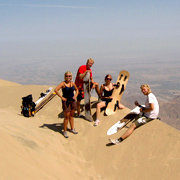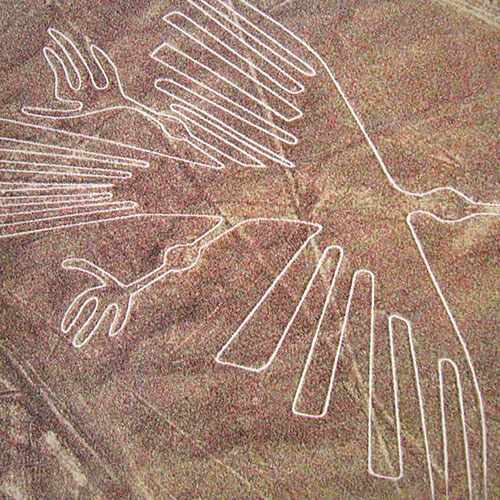The city of Nazca is located in the central southern region of Peru, in a narrow valley 280mi south of Lima. Part of the Nazca Province, one of the 5 provinces of the coastal desert Department of Ica, it's situated on the right-hand margin of the Aja River. Its climate is dry, warm and sunny all year long, with an average temperature of 73°F. The constant sunshine has earned it the nickname The City of Eternal Summer. During the January to March summertime months, temperatures can exceed 86°F.
A few hours outside of the city of Nazca, one finds the Pampa Galeras National Reserve, protected grasslands for the conservation of the graceful Vicuña and other endangered animals such as the Andean Condor, Andean Ostrich, Andean Deer, and Suri (breed of Alpaca).
Another notable geographic feature is Cerro Blanco, White Hill, thought to be the world's largest sandune at 6817ft above sea level. Known to the ancient Nazca as Yuraq Orjo, it was a sacred spot to which they rendered offerings. Today, it's a popular spot for sandboarding. For a relaxing post-sandboarding stop, one can visit nearby Huacachina Oasis, a lagoon surrounded with lush royal and date palms and huarango trees.
The Paracas Civilization flourished in this area from 800-100BC (it was centered in the Paracas Peninsula, and thus more information is available about the Paracas Civilization in the section on the history of Ica), after which it became the cradle of the Nazca Culture, from 100-800AD. They continued the Paracas tradition of intricate textiles, but are most known for their impressive multicolored ceramics with surrealistic designs. They developed throughout the Nazca Valley a unique system of subterranean aqueducts, which despite thousands of years are still in use by locals. The best-preserved of these are the Cantayoc Aqueducts.
Another astounding site is adobe city of Cahuachi (Home of the Clairvoyants), which was abandoned around 400AD when the Nazca Civilization was already in decline, plagued by disastrous floods and earthquakes. A ceremonial center and pilgrimage site, it includes staggered pyramids and a necropolis.
After the decline of the Nazca the reach of the Inca Empire extended to this area of Peru, with Nazca falling under the contorl of Tupac Inca around 1471. Chroniclers have indicated that during this time the Nazca Valley was known as Caxamarca.
The Spanish conquered the region in 1591; the city was founded by the viceroy García Hurtado de Mendoza, Marquis of Cañete, and continued developing as an agriculture-based urban center.
During the Wars of Independence, General San Martín ordered Lieutenant Coronel Manuel Rojas to lead one of the divisions through the south of Ica, where they clashed with royalists during the Battle of Nazca, liberating Nazca on Oct. 14th 1820 in the first Independence battle in Peru, four years before the Spanish would be decisively defeated in other regions.
Without a doubt the most famous mark the Nazca left on the land was the enigmatic Nazca Lines, but as they can only be seen by air, these were not discovered until the 1930s. These gigantic geoglyphs cover miles of the desert floor in geometric designs and representations of animals and people. Their purpose remains a mystery, but the leading theories contend that they were the world's largest astronomical calendar, correlating with celestial movements and perhaps meant to remind the gods of the seasonal needs of the the crops and harvests.

01 dias /0 noches
